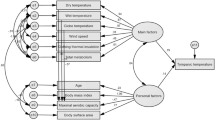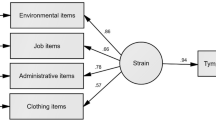Abstract
Objectives
There have been increased interests in research on quantifying heat strain of construction workers and formulating corresponding guidelines for working in hot weather. The aim of this study was to validate a subjective measurement tool, the perceptual strain index (PeSI), for measuring heat strain in real-work settings.
Methods
A total of sixteen construction workers were invited to participate in the field surveys. Empiric-based human monitoring was carried out with simultaneous micrometeorological (wet-bulb globe temperature, WBGT), physiological (heart rate, HR), and perceptual (perceived exertion, RPE; thermal sensation, TS) measurements throughout the test. The relative heart rate (RHR), the physiological strain index (PSIHR), and the PeSI were then calculated accordingly.
Results
The PeSI exhibited moderate correlations with WBGT and RHR (r = 0.42 and 0.40, respectively), which indicated the PeSI was sensitive to the variants of WBGT and RHR. The results of regression analysis indicated that the PeSI changed in the same general manner as the PSIHR, with a relatively large determination coefficient (R 2 = 0.67). The established perceptual strain zone illustrated that the PeSI ranging from 7 to 8 would be the exposure limit of construction workers in hot weather.
Conclusion
The PeSI is a simple, robust, reliable, and user-friendly tool for heat strain assessment in occupational settings. The perceptual strain zone will provide practical guidelines for on-site heat strain monitoring for construction workers.



Similar content being viewed by others
Abbreviations
- HR:
-
Heart rate (beat/min)
- PeSI:
-
Perceptual strain index
- PSI:
-
Physiological strain index
- RHR:
-
Relative heart rate
- RPE:
-
Rating of perceived exertion
- TS:
-
Thermal sensation
- WBGT:
-
Wet-bulb globe temperature (°C)
References
Adeodu AO, Daniyan IA, Dada OM (2014) An assessment of physical strain experienced by manual workers in brick laying operation: a case study in Nigeria. J Comp Biosci Eng 1(1):1–6
Borg GAV (1998) Borg’s perceived exertion and pain scales. Human Kinetics, Champaign
BS 7963 (2000) British standard: ergonomics of the thermal environment—guide to the assessment of heat strain in workers wearing personal protective equipment. British Standards Institution, London
Budd GM (2008) Wet-bulb globe temperature (WBGT)—its history and its limitations. J Sci Med Sport 11(1):20–32
Chan AP, Yam MC, Chung JW, Yi W (2012a) Developing a heat stress model for construction workers. J Facil Manag 10(1):59–74
Chan AP, Yi W, Wong DP, Yam MC, Chan DW (2012b) Determining an optimal recovery time for construction rebar workers after working to exhaustion in a hot and humid environment. Build Environ 58:163–171
Cheung SS (2007) Neuropsychological determinants of exercise tolerance in the heat. Prog Brain Res 162:45–60
de Freitas CR, Scott D, McBoyle G (2008) A second generation climate index for tourism (CIT): specification and verification. Int J Biometeorol 52(5):399–407
Epstein Y, Moran DS (2006) Thermal comfort and the heat stress indices. Ind Health 44(3):388–398
Gagge AP, Stolwijk JA, Hardy JD (1967) Comfort and thermal sensations and associated physiological responses at various ambient temperatures. Environ Res 1:1–20
Gallagher M Jr, Robertson RJ, Goss FL, Nagle-Stilley EF, Schafer MA, Suyama J, Hostler D (2012) Development of a perceptual hyperthermia index to evaluate heat strain during treadmill exercise. Eur J Appl Physiol 112(6):2025–2034
Hartmann B, Fleischer AG (2005) Physical load exposure at construction sites. Scand J Work Environ Health 31(2):88–95
Hostler D, Gallagher M, Goss FL, Seitz JR, Reis SE, Robertson RJ, Northington WE, Suyama J (2009) The effect of hyperhydration on physiological and perceived strain during treadmill exercise in personal protective equipment. Eur J Appl Physiol 105(4):607–613
Inaba R, Mirbod SM (2007) Comparison of subjective symptoms and hot prevention measures in summer between traffic control workers and construction workers in Japan. Ind Health 45(1):91–99
Kántor N, Égerházi L, Unger J (2012) Subjective estimation of thermal environment in recreational urban spaces—part 1: investigations in Szeged, Hungary. Int J Biometeorol 56(6):1075–1088
Kjellstrom T, Crowe J (2011) Climate change, workplace heat exposure, and occupational health and productivity in central America. Int J Occup Environ Health 17(3):270–281
Knes I, Thorsson S (2006) Influences of culture and environmental attitude on thermal, emotional and perceptual evaluations of a public square. Int J Biometeorol 50:258–268
Maiti R (2008) Workload assessment in building construction related activities in India. Appl Ergon 39(6):754–765
Miller VS, Bates GP (2007) The Thermal Work Limit is a simple reliable heat index for the protection of workers in thermally stressful environments. Ann Occup Hyg 51(6):553–561
Miller V, Bates G, Schneider JD, Thomsen J (2011) Self-pacing as a protective mechanism against the effects of heat stress. Ann Occup Hyg 55(5):548–555
Moran DS, Pandolf KB, Heled MY, Gonzalez R (2001) Integration between the environmental stress index (ESI) and the physiological strain index (PSI) as a guideline for training. Defense Technical Information Center Compilation Part Notice ADP012440
Moran DS, Pandolf KB, Shapiro Y, Laor A, Heled Y, Gonzalez RR (2003) Evaluation of the environmental stress index for physiological variables. J Therm Biol 28(1):43–49
Nielsen B, Nybo L (2003) Cerebral changes during exercise in the heat. Sports Med 33:1–11
Nikolopoulou M, Steemers K (2003) Thermal comfort and psychological adaptation as a guide for designing urban spaces. Energ Buildings 70:227–235
NIOSH (National Institute for Occupational Safety and Health) (1986) Criteria for a recommended standard: occupational exposure to hot environment. DHHS (NIOSH) Publication No 86-113, 101-10. Washington DC
Pearlmutter D, Jiao D, Garb Y (2014) The relationship between bioclimatic thermal stress and subjective thermal sensation in pedestrian spaces. Int J Biometeorol 58(10):2111–2127
Petruzzello SJ, Gapin JI, Snook E, Smith DL (2009) Perceptual and physiological heat strain: examination in firefighters in laboratory-and field-based studies. Ergonomics 52(6):747–754
Rodahl K (1989) The physiology of work. Taylor & Francis, London
Rowlinson S, Jia YA (2014) Application of the predicted heat strain model in development of localized, threshold-based heat stress management guidelines for the construction industry. Ann Occup Hyg 58(3):326–339
Rowlinson S, YunyanJia A, Li B, ChuanjingJu C (2014) Management of climatic heat stress risk in construction: a review of practices, methodologies, and future research. Accid Anal Prev 66:187–198
Shimaoka M, Hiruta S, Ono Y, Nonaka H, Hjelm EW, Hagberg M (1997) A comparative study of physical work load in Japanese and Swedish nursery school teachers. Euro J Appl Physiol Occup Physiol 77(1–2):10–18
Snook E, Petruzzello SJ, Smith DL (2004) Perceptual and physiological heat strain: examination in firefighters performing simulated firefighting activities in the heat. Med Sci Sports Exerc 36(5):S219–S220
Tikuisis P, Mclellan TM, Selkirk G (2002) Perceptual versus physiological heat strain during exercise-heat stress. Med Sci Sports Exerc 34(9):1454–1461
Wong DPL, Chung JWY, Chan APC, Wong FKW, Yi W (2014) Comparing the physiological and perceptual responses of construction workers (bar benders and bar fixers) in a hot environment. Appl Ergon 45(6):1705–1711
Wright HE, Larose J, McLellan TM, Miller S, Boulay P, Kenny GP (2013) Do older firefighters show long-term adaptations to work in the heat? J Occup Environ Hyg 10(12):705–715
Yang Y, Chan APC (2015) Perceptual strain index for heat strain assessment in an experimental study: an application to construction workers. J Therm Biol 48:21–27
Yi W, Chan AP (2014) Which environmental indicator is better able to predict the effects of heat stress on construction workers? J Manage Eng. doi:10.1061/(ASCE)ME.1943-5479.0000284,04014063
Zhao J, Zhu N, Lu S (2009) Productivity model in hot and humid environment based on heat tolerance time analysis. Build Environ 44(11):2202–2207
Acknowledgments
This project is funded by a Grant from the Research Grants Council of the Hong Kong Special Administrative Region, China (RGC Project No. PolyU5107/11E). The research team is indebted to the technical support from technicians of the Hong Kong Polytechnic University. In particular, the participation of volunteers in this study is gratefully acknowledged. This paper forms part of the research project titled “Anti-heat stress clothing for construction workers in hot and humid weather”, from which other deliverables will be produced with different objectives/scopes but sharing common background and methodology. The authors also wish to acknowledge the contributions to other team members including Prof. Francis Wong, Dr. Michael Yam, Dr. Daniel Chan, Dr. Edmond Lam, Dr. Del Wong, Prof. Li Yi, Dr. YP Guo, Dr. WF Song, Dr. W Yi, Dr. Esther Cheung, and Prof. Joanne Chung.
Conflict of interest
The authors declare that they have no conflict of interest.
Author information
Authors and Affiliations
Corresponding author
Rights and permissions
About this article
Cite this article
Chan, A.P.C., Yang, Y. Practical on-site measurement of heat strain with the use of a perceptual strain index. Int Arch Occup Environ Health 89, 299–306 (2016). https://doi.org/10.1007/s00420-015-1073-7
Received:
Accepted:
Published:
Issue Date:
DOI: https://doi.org/10.1007/s00420-015-1073-7




